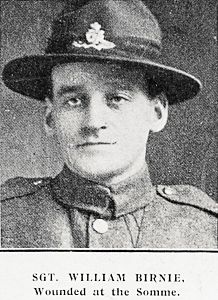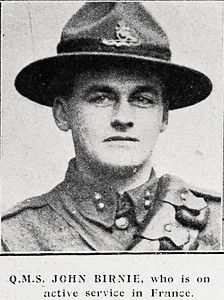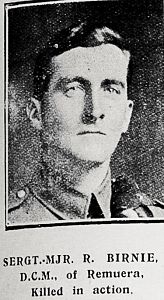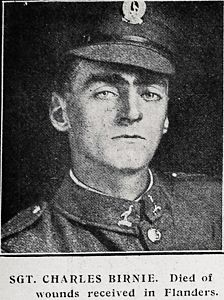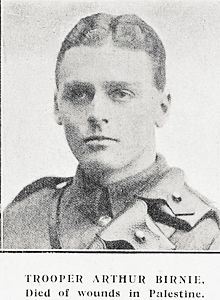WW1 The Birnie Boys
The seven Birnie boys were born across 15 years to John and Agnes Birnie of 11 O’Rorke Ave, Remuera.
Today the street is known as Mauranui Ave, off St Mark’s Road. The boys’ service saw six of them go to war, three of them die, three return and two awarded medals of gallantry.
Their father Major John Birnie, owner of a bakery business in Arch Hill, had joined the army in 1899 as a volunteer officer and held the Colonial and Auxiliary Forces and the New Zealand long service and efficiency medals, and was the chief of staff of the National Reserve in 1916.
The eldest son Sergeant William Birnie, of the Seventh Battery N.Z. Field Artillery, who was well known in North Auckland as a bridge-builder for the Public Works Department, was on the staff of Messrs. Brown Bros. and Geddes, of Auckland. He was captain of the City second football team, who won their caps in 1914. He enrolled in the Waikato Mounted Rifles, but in Egypt was transferred to a machine-gun section. At Gallipoli he sustained shell-shock, and was invalided to England. Returning to Egypt, he joined the Field Artillery, with which he went onto France. He was wounded at the Somme in 1916 and took part in the Messines battle. William was awarded the Military Medal when he was a Sergeant for acts of gallantry in the field. He returned home on 1 February 1919 on the Hororata, and resumed his occupation of salesman with Brown Bros and Geddes.
John, the second son, was born on 29 November 1884, and at enlistment was employed as a carpenter with the Farmer’s Auction Co, Hamilton. He was five feet seven inches tall with dark hair and blue eyes. He enlisted on 13 August 1914 in Auckland, and embarked for Egypt on 16 October 1914 on the HMNZT Limerick, arriving in Egypt on 3 December 1914. He served at Gallipoli but in August 1915 was admitted to hospital in Alexandria and discharged for convalescence, and granted indefinite leave without pay but still liable for further service. He then saw action in France as a Battery Quarter Sergeant Master and returned to New Zealand on duty furlough on the Remuera on 14 March 1918.
George Birnie was born on 2 February 1887 and worked for the New Zealand Government Post and Telegraph Department as a Telegraphist. On 9 December 1915 he married Irene Sarah Adeline Peters in Westport and a son Robert was born on 2 May 1917. George enlisted on 24 June 1917, and on 8 February departed as a Second Lieutenant with 34th Reinforcements, Auckland Infantry Regiment, A Company from Wellington on the Ulimaroa via Panama for Liverpool, arriving on 29 March. While serving in France in the advance on Bapaume he fell over a bank and sprained his ankle and was admitted to hospital in September 1918 in Rouen and in England. He returned to New Zealand after the war on 8 October 1919 and was absorbed into the corps of the NZ Engineers in the NZ Post and Telegraph with the rank of Captain. He was postmaster at Helensville and Morrinsville until his retirement in 1941.
Robert Birnie was born on 27 April 1889 in Auckland. He was educated at Grafton School and was a member of the College Rifles Football Club. His occupation before enlistment is recorded as Labourer with Harrison & Gash, Coach Builders, of Khyber Pass, Auckland. He was a member of the A Battery Field Artillery, being discharged with a first-class certificate. He was 5ft 10in tall, with fair hair and blue eyes when he enlisted on 13 August 1914, joining the NZ Field Artillery as a Gunner. He embarked on the HMNZT Limerick on 16 October 1914, disembarking at Alexandria and headed for the Dardanelles. He was promoted 25.August 1915 to Sergeant. Serving throughout the whole of the Gallipoli campaign, he was wounded twice but was never away from duty. On one occasion a high explosive shell burst over his gun, killed one of his companions and slightly wounded him. He continued on duty until evacuation from the peninsula. He was awarded the Distinguished Conduct Medal for conspicuous gallantry in the field at Gallipoli on 23 August 1916. “On four occasions he has done fine work, serving his gun and repairing emplacements under heavy fire.” He was also mentioned in Sir Charles Monro’s despatches for distinguished and gallant services at Gallipoli. He then left Egypt for France in April 1916 with the newly established New Zealand Division, where he was killed in action in the field at the Somme, Northern France 21 October 1916 and is buried east of Flers Eaucourt L’Abbaye Road, Flers.
Charles Birnie was born in Auckland on 21 May 1893, the fourth son of John and Agnes Birnie. He was a motor mechanic employed by F. Parker, and a taxi proprietor. He was six feet two inches tall with brown hair and blue eyes. On 15 December 1914 he enlisted with the 4th Reinforcements as a Gunner. He departed from Wellington on 17 April 1915 to Egypt Motor Transport Corp. On 30 October 1915 he contracted enteric fever, was admitted to the Enteric Convalescent Camp in Port Said and on I January 1916 he came home to New Zealand on the Hospital Ship Maheno. He was discharged 27/3/1916 as medically unfit. He re-enlisted early 1917 in 22nd Reinforcements E Company and embarked on 13 February 1917 on the Mokoia from Wellington; arriving at Sling Camp on 2 May 1917. On 6 June he left for France, joining the Battalion at Etaples. On 31 July at Flanders he was seriously wounded with head injuries and died of his wounds on 26 August 1917. He is buried in the St Sever Cemetery Extension at Rouen.
Arthur Birnie was born in the Coromandel on 7 July 1895. After leaving school he became a Warehouseman with Hayman & Co, Auckland and enlisted on 8 March 1916 at Featherston into the Auckland Mounted Rifles, 15th Reinforcements. He embarked on 13 July 1916 in Wellington on the HMNZT Manuka, arriving in Suez Egypt on 24 Aug 1916. He was detached to the School of Instruction to Zeitoun, near Cairo, to prepare for what was to be a tortuous advance north-east across the Sinai Desert during the Sinai Campaign. The action at Ayun Kara on the 14th November 1917 was carried out by the New Zealand Mounted Rifles on heavily entrenched Turkish defences. This successful rout of the enemy is remembered for its daring frontal rush by mounted troops and tactical movements in support by the Brigade’s riflemen and machine gunners. Trooper Arthur Birnie was wounded in action and died of wounds aged 21 near Jaffa in Palestine on 14 November 1917. He is buried in the Ramleh War Cemetery, which contains 3,300 Commonwealth burials of the First World War, 964 of them unidentified.
The youngest son, Gordon Birnie, was called up in the ballot system. He appeared before the Military Service Board on Thursday and his appeal was allowed on the grounds that he was not of military age. His father stated that his lad was anxious to go to the front but his parents were wishful that he remain until he came of military age. He served as a driver doing local service in the A Battery in Auckland.
See also the digital issue of The Hobson for July/August 2015.

